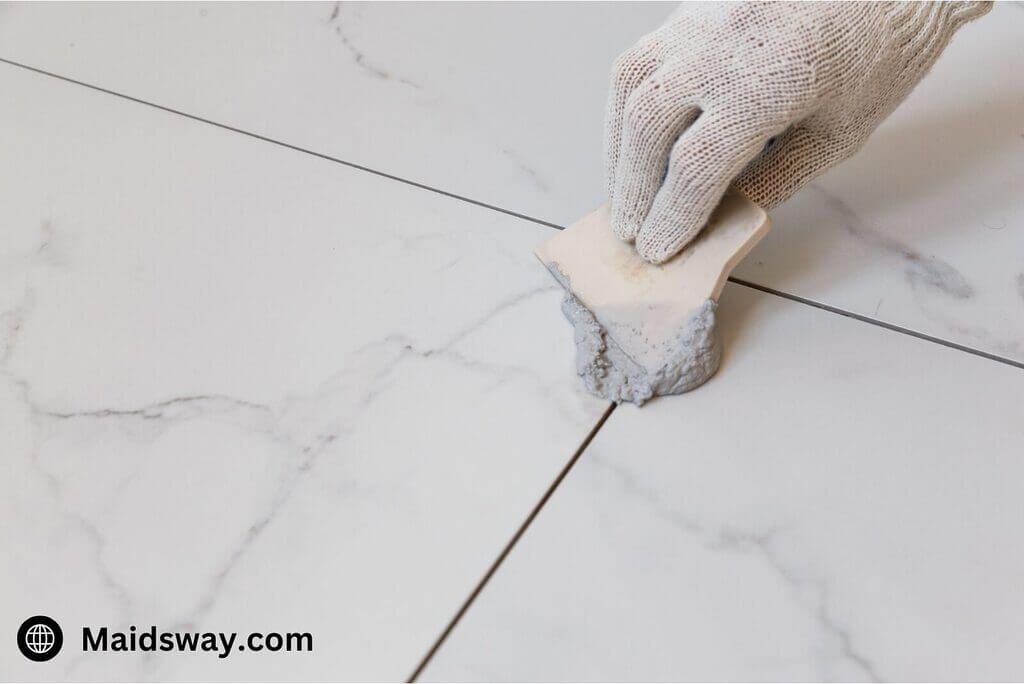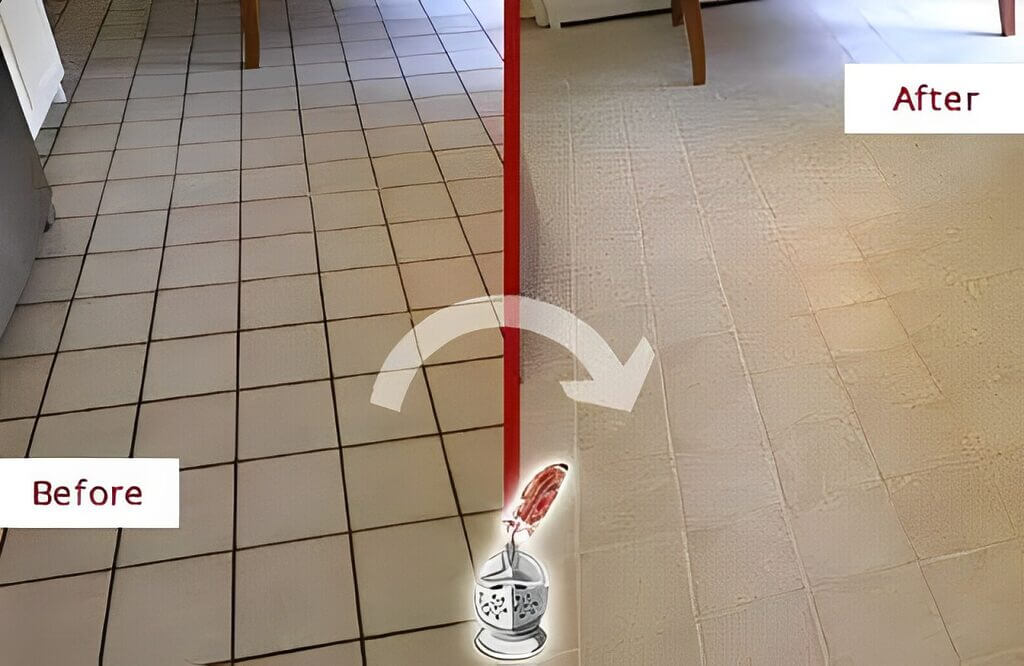How to Seal Grout?
Understanding how to properly seal grout often involves more than just basic cleaning methods. It can be a task too complex for your cleaning service to manage. This skill becomes crucial when you’re preparing to put your property on the real estate market. This guide is especially useful for homeowners and enthusiastic real estate professionals.
Ceramic tile floors are beautiful, durable, and easy to maintain. The problem with maintaining the new look of ceramic tile floors is not the tile itself but keeping the grout clean. There are several ways to address the maintenance of your grout but the most important thing to understand is the appropriate care for your flooring.
How to Apply Grout Sealer?
Applying grout sealer is an essential step in maintaining your tiled surfaces. Here’s a closer look at the application process:
- Preparation: Start by gathering your materials—grout sealer, a small brush or applicator bottle, a clean cloth, and protective gloves.
- Application: Begin at one corner of the tiled area and work your way across. Apply the sealer carefully along the grout lines, ensuring complete coverage. It’s best to work in small sections to prevent the sealer from drying on the tile surface.
- Work the Sealer Into the Grout: As you apply the sealer, use the brush or applicator to work it into the grout, ensuring it penetrates deeply for maximum protection.
- Wipe Away Excess: Immediately after application, wipe away any sealer that has spread onto the tiles. Use a clean, dry cloth to prevent the sealer from leaving a residue.
- Drying Time: Allow the sealer to dry for the recommended time before applying a second coat if needed.
How to Seal Grout? Step-by-Step Guide
Sealing grout is a straightforward process, but it requires attention to detail to ensure complete coverage. Here’s a step-by-step guide:
- Choose the Right Sealer: There are different types of grout sealers, including penetrating sealers and membrane-forming sealers. Penetrating sealers are absorbed into the grout and are ideal for areas exposed to moisture. Membrane-forming sealers create a barrier on the surface and are often used in low-moisture areas.
- Clean the Grout: Before applying the sealer, make sure the grout is thoroughly cleaned. Use a mild cleaner and a brush to remove any dirt, grease, or soap scum. Rinse the area with clean water and let it dry completely.
- Apply the Sealer: Use a small brush, roller, or applicator bottle to apply the sealer evenly over the grout lines. Be careful not to get sealer on the tiles, as it can leave a residue. If you do, wipe it off immediately with a clean cloth.
- Let the Sealer Penetrate: Allow the sealer to sit for the time recommended by the manufacturer, usually about 5-10 minutes. This gives the sealer time to penetrate the grout.
- Wipe-Off Excess Sealer: After the sealer has penetrated, wipe off any excess with a clean, dry cloth. Leaving excess sealer on the surface can cause a hazy appearance.
- Apply a Second Coat (If Necessary): For added protection, consider applying a second coat of sealer, especially in high-traffic areas or places with heavy moisture exposure.
- Allow the Sealer to Cure: Once the sealer has been applied and the excess wiped away, allow the grout to cure according to the manufacturer’s instructions, typically 24-48 hours before regular use.

When to Seal Grout?
Sealing grout should be done when it has completely cured. This is usually required for cement-based grout, which is porous and can collect moisture, stains, and debris. If grout is not sealed, it will swiftly discolor and disintegrate over time. Sealing is especially necessary in damp environments like bathrooms, kitchens, and outdoor areas.
For new installations, seal the grout when it has completely dried. If your grout has never been treated, it’s never too late to apply a sealer, especially if you see deterioration or staining.
How Long After Grouting Can You Seal?
After grouting, allow the grout to fully cure before applying a sealant. Typically, grout should cure for at least 48-72 hours after application. This time range allows the grout to firm and cure entirely, ensuring that the sealer adheres properly and offers adequate protection.
Sealing grout too soon can retain moisture, causing damage and reducing the efficiency of the sealer. Refer to the grout manufacturer’s directions for particular cure timeframes.
How Long Should Grout Dry Before Sealing?
Before applying a sealant, ensure that the grout is dry. The drying period varies according to the type of grout used, humidity level, and temperature of the surroundings. In general, grout should dry for at least 48-72 hours before sealing.
Before sealing, check the grout for signs of dampness. If the grout appears moist or discolored, allow it to dry longer. Patience is essential for achieving a durable and long-lasting seal.
Keeping your grout clean
Let’s discuss the tile floor. The tile is the largest surface with the grout lines slightly below the tile. The grout line becomes a sink where the fluid runs off the tile and collects water and soil. Since grout is porous, any moisture that gets in the grout is absorbed into the grout. Since the fluid is the carrier, after the fluid evaporates what remains are the solids or stains. These solids or stains can build up over time providing unsightly grout lines.
With this understanding, there are things a homeowner can do to help maintain the clean appearance of the grout lines. Like any other floor, dirt, and material that stains are the enemy. Placing rugs or mats at entryways and high-traffic areas to help capture the dirt is beneficial. Daily living provides many other items that stain and can find their way into the grout so it is best to understand how to minimize exposing your grout.

Unless stain-proof grout is used, the grout will need to be sealed. Allow the grout in new floors to cure for 30 days before sealing. If the grout is stained or dirty, use a mild bleach solution and scrub brush to clean it, then allow the floor to dry completely before sealing.
Grout, used to fill the gaps between ceramic tile, stone tile, and masonry, is made of a mixture of cement, sand, and water. It is extremely porous and stains easily. Seal it twice a year with a penetrating grout sealer, available from home centers or hardware stores, following the label directions. It is best to apply the sealer to the grout with a small foam brush; excess can be buffed off the tile and will not leave any lasting residue.
Conclusion
Sealing grout is an important step in protecting tiled surfaces from stains, moisture, and damage. Understanding when to seal the grout, how to apply the sealer, and the timing considerations are critical for getting the greatest results. Following these rules will guarantee that your grout remains in good condition, keeping your tiles fresh and clean for many years to come.
FAQs
Is it necessary to seal the grout?
Yes, sealing grout is necessary to protect it from moisture, stains, and dirt, extending its lifespan and maintaining its appearance.
Should I seal my grout?
If your grout is cement-based and in areas exposed to moisture, sealing it is highly recommended to prevent damage and discoloration.
What does sealing grout do?
Sealing grout creates a protective barrier that repels water, stains, and contaminants, keeping your grout lines clean and durable.
How often should I seal grout?
Grout should be sealed every 1-2 years, depending on the area and the amount of wear and tear it experiences.

